Organizational Behavior and Efficiency
VerifiedAdded on 2020/01/21
|12
|4126
|408
AI Summary
The assignment delves into the crucial role of organizational behavior in enhancing employee efficiency. It emphasizes the significance of adopting motivational theories and effective leadership styles to improve performance. The document also highlights the need for integrating modern technology and fostering a positive workplace culture to achieve optimal results.
Contribute Materials
Your contribution can guide someone’s learning journey. Share your
documents today.
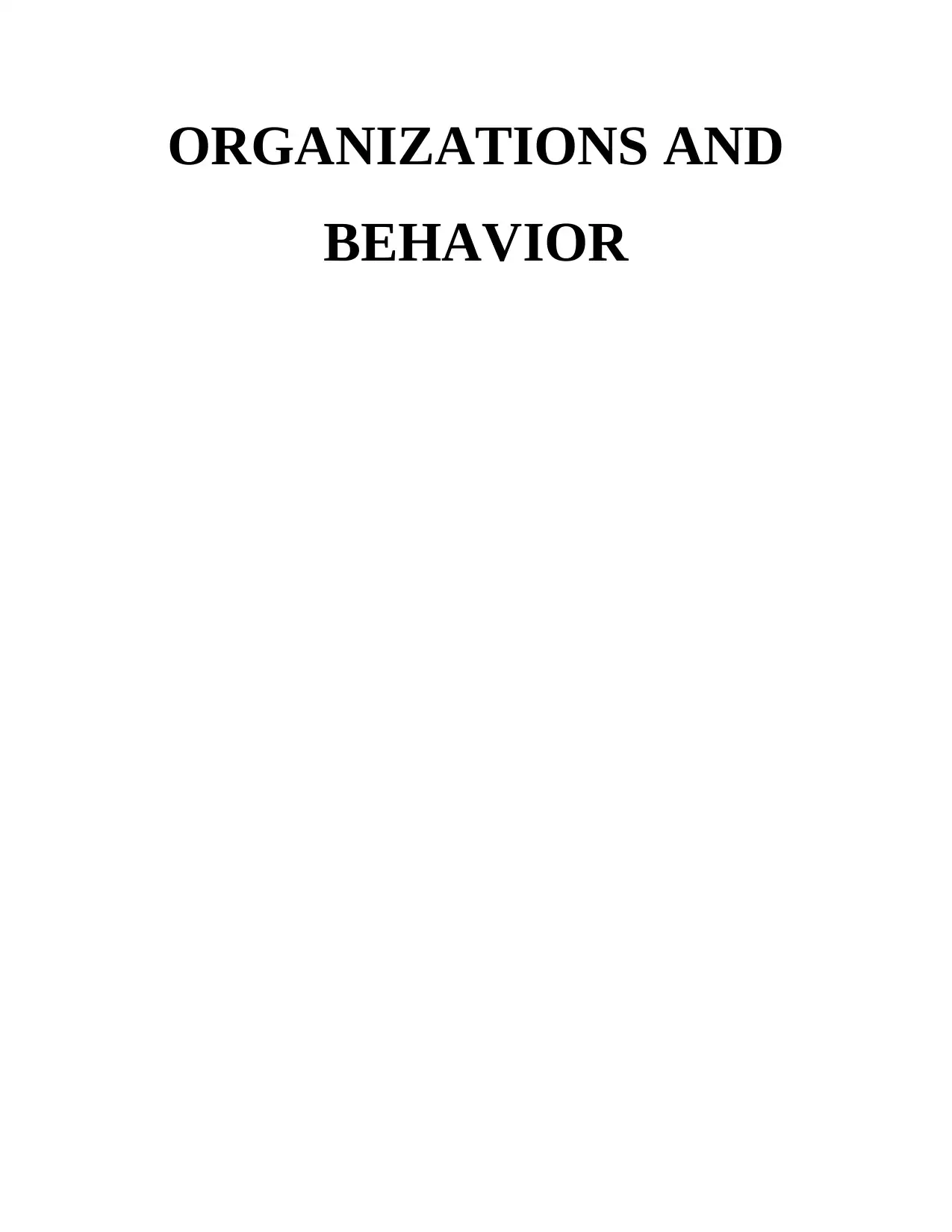
ORGANIZATIONS AND
BEHAVIOR
BEHAVIOR
Secure Best Marks with AI Grader
Need help grading? Try our AI Grader for instant feedback on your assignments.
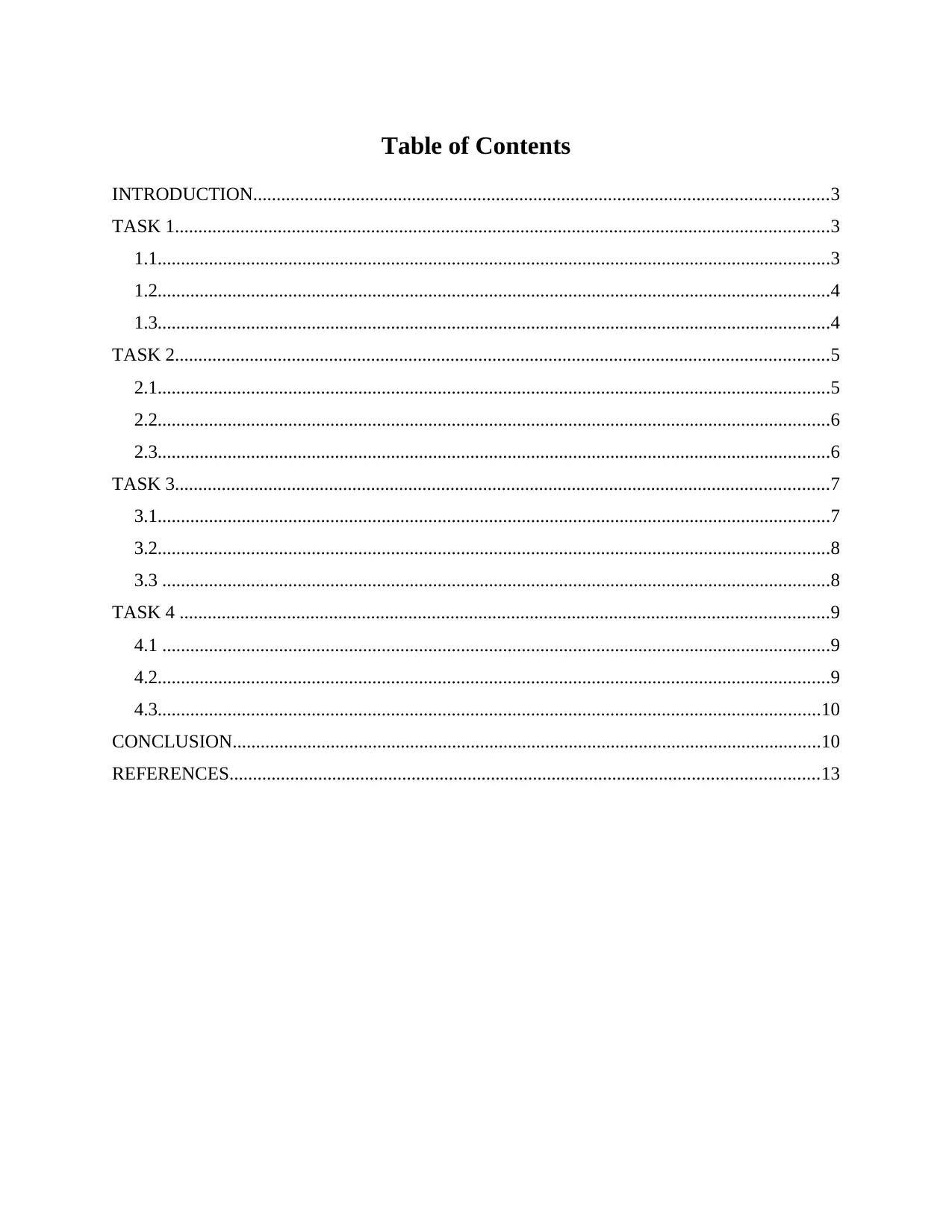
Table of Contents
INTRODUCTION...........................................................................................................................3
TASK 1............................................................................................................................................3
1.1................................................................................................................................................3
1.2................................................................................................................................................4
1.3................................................................................................................................................4
TASK 2............................................................................................................................................5
2.1................................................................................................................................................5
2.2................................................................................................................................................6
2.3................................................................................................................................................6
TASK 3............................................................................................................................................7
3.1................................................................................................................................................7
3.2................................................................................................................................................8
3.3 ...............................................................................................................................................8
TASK 4 ...........................................................................................................................................9
4.1 ...............................................................................................................................................9
4.2................................................................................................................................................9
4.3..............................................................................................................................................10
CONCLUSION..............................................................................................................................10
REFERENCES..............................................................................................................................13
INTRODUCTION...........................................................................................................................3
TASK 1............................................................................................................................................3
1.1................................................................................................................................................3
1.2................................................................................................................................................4
1.3................................................................................................................................................4
TASK 2............................................................................................................................................5
2.1................................................................................................................................................5
2.2................................................................................................................................................6
2.3................................................................................................................................................6
TASK 3............................................................................................................................................7
3.1................................................................................................................................................7
3.2................................................................................................................................................8
3.3 ...............................................................................................................................................8
TASK 4 ...........................................................................................................................................9
4.1 ...............................................................................................................................................9
4.2................................................................................................................................................9
4.3..............................................................................................................................................10
CONCLUSION..............................................................................................................................10
REFERENCES..............................................................................................................................13
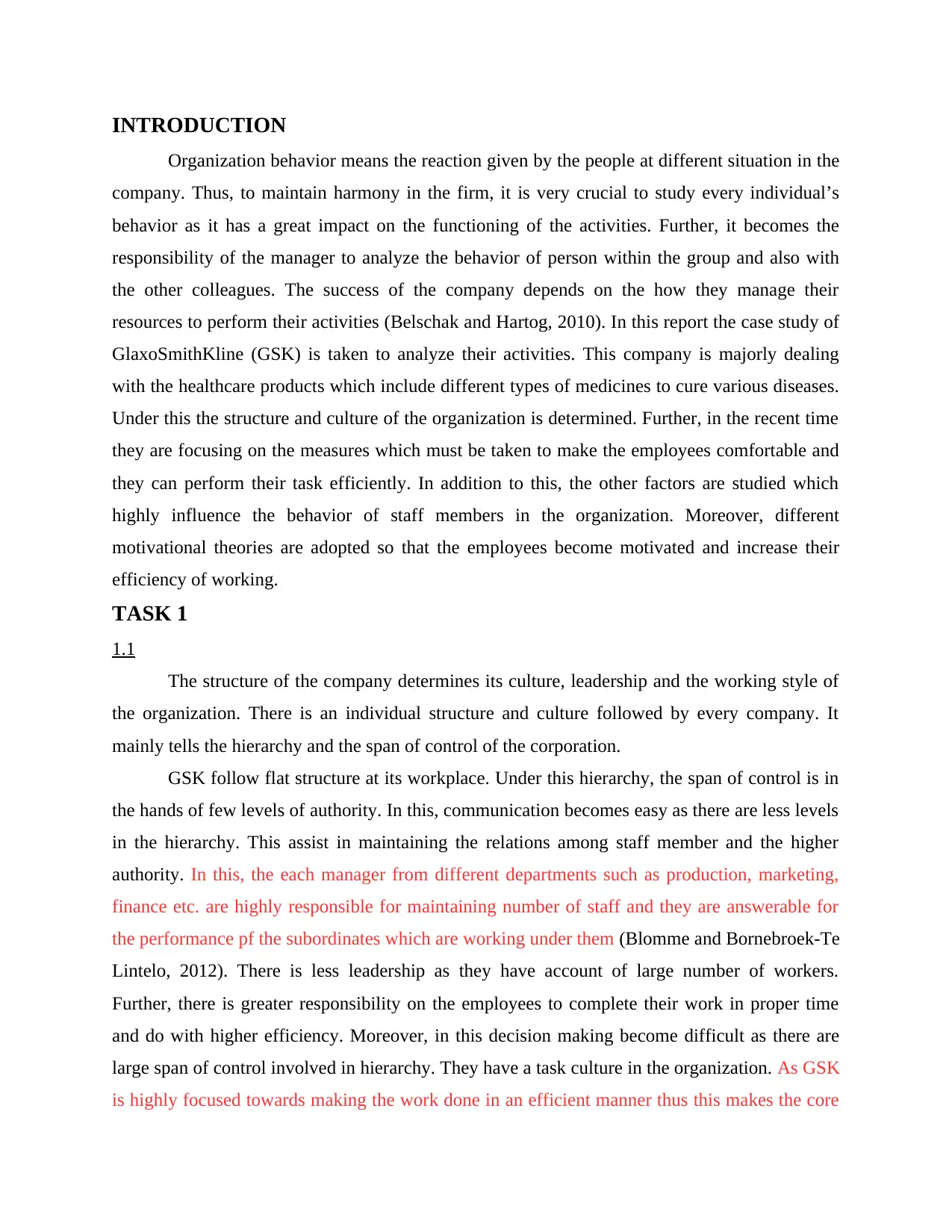
INTRODUCTION
Organization behavior means the reaction given by the people at different situation in the
company. Thus, to maintain harmony in the firm, it is very crucial to study every individual’s
behavior as it has a great impact on the functioning of the activities. Further, it becomes the
responsibility of the manager to analyze the behavior of person within the group and also with
the other colleagues. The success of the company depends on the how they manage their
resources to perform their activities (Belschak and Hartog, 2010). In this report the case study of
GlaxoSmithKline (GSK) is taken to analyze their activities. This company is majorly dealing
with the healthcare products which include different types of medicines to cure various diseases.
Under this the structure and culture of the organization is determined. Further, in the recent time
they are focusing on the measures which must be taken to make the employees comfortable and
they can perform their task efficiently. In addition to this, the other factors are studied which
highly influence the behavior of staff members in the organization. Moreover, different
motivational theories are adopted so that the employees become motivated and increase their
efficiency of working.
TASK 1
1.1
The structure of the company determines its culture, leadership and the working style of
the organization. There is an individual structure and culture followed by every company. It
mainly tells the hierarchy and the span of control of the corporation.
GSK follow flat structure at its workplace. Under this hierarchy, the span of control is in
the hands of few levels of authority. In this, communication becomes easy as there are less levels
in the hierarchy. This assist in maintaining the relations among staff member and the higher
authority. In this, the each manager from different departments such as production, marketing,
finance etc. are highly responsible for maintaining number of staff and they are answerable for
the performance pf the subordinates which are working under them (Blomme and Bornebroek-Te
Lintelo, 2012). There is less leadership as they have account of large number of workers.
Further, there is greater responsibility on the employees to complete their work in proper time
and do with higher efficiency. Moreover, in this decision making become difficult as there are
large span of control involved in hierarchy. They have a task culture in the organization. As GSK
is highly focused towards making the work done in an efficient manner thus this makes the core
Organization behavior means the reaction given by the people at different situation in the
company. Thus, to maintain harmony in the firm, it is very crucial to study every individual’s
behavior as it has a great impact on the functioning of the activities. Further, it becomes the
responsibility of the manager to analyze the behavior of person within the group and also with
the other colleagues. The success of the company depends on the how they manage their
resources to perform their activities (Belschak and Hartog, 2010). In this report the case study of
GlaxoSmithKline (GSK) is taken to analyze their activities. This company is majorly dealing
with the healthcare products which include different types of medicines to cure various diseases.
Under this the structure and culture of the organization is determined. Further, in the recent time
they are focusing on the measures which must be taken to make the employees comfortable and
they can perform their task efficiently. In addition to this, the other factors are studied which
highly influence the behavior of staff members in the organization. Moreover, different
motivational theories are adopted so that the employees become motivated and increase their
efficiency of working.
TASK 1
1.1
The structure of the company determines its culture, leadership and the working style of
the organization. There is an individual structure and culture followed by every company. It
mainly tells the hierarchy and the span of control of the corporation.
GSK follow flat structure at its workplace. Under this hierarchy, the span of control is in
the hands of few levels of authority. In this, communication becomes easy as there are less levels
in the hierarchy. This assist in maintaining the relations among staff member and the higher
authority. In this, the each manager from different departments such as production, marketing,
finance etc. are highly responsible for maintaining number of staff and they are answerable for
the performance pf the subordinates which are working under them (Blomme and Bornebroek-Te
Lintelo, 2012). There is less leadership as they have account of large number of workers.
Further, there is greater responsibility on the employees to complete their work in proper time
and do with higher efficiency. Moreover, in this decision making become difficult as there are
large span of control involved in hierarchy. They have a task culture in the organization. As GSK
is highly focused towards making the work done in an efficient manner thus this makes the core
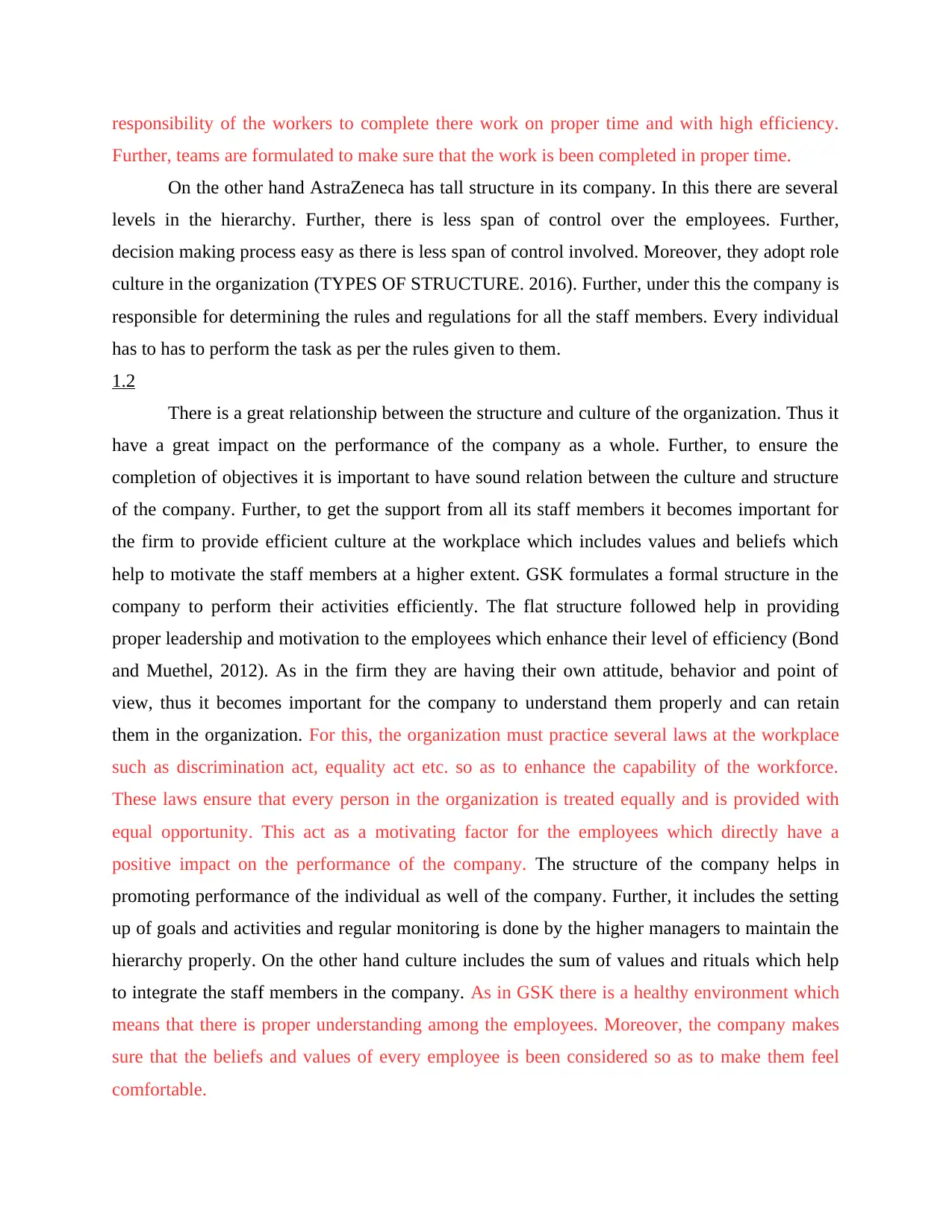
responsibility of the workers to complete there work on proper time and with high efficiency.
Further, teams are formulated to make sure that the work is been completed in proper time.
On the other hand AstraZeneca has tall structure in its company. In this there are several
levels in the hierarchy. Further, there is less span of control over the employees. Further,
decision making process easy as there is less span of control involved. Moreover, they adopt role
culture in the organization (TYPES OF STRUCTURE. 2016). Further, under this the company is
responsible for determining the rules and regulations for all the staff members. Every individual
has to has to perform the task as per the rules given to them.
1.2
There is a great relationship between the structure and culture of the organization. Thus it
have a great impact on the performance of the company as a whole. Further, to ensure the
completion of objectives it is important to have sound relation between the culture and structure
of the company. Further, to get the support from all its staff members it becomes important for
the firm to provide efficient culture at the workplace which includes values and beliefs which
help to motivate the staff members at a higher extent. GSK formulates a formal structure in the
company to perform their activities efficiently. The flat structure followed help in providing
proper leadership and motivation to the employees which enhance their level of efficiency (Bond
and Muethel, 2012). As in the firm they are having their own attitude, behavior and point of
view, thus it becomes important for the company to understand them properly and can retain
them in the organization. For this, the organization must practice several laws at the workplace
such as discrimination act, equality act etc. so as to enhance the capability of the workforce.
These laws ensure that every person in the organization is treated equally and is provided with
equal opportunity. This act as a motivating factor for the employees which directly have a
positive impact on the performance of the company. The structure of the company helps in
promoting performance of the individual as well of the company. Further, it includes the setting
up of goals and activities and regular monitoring is done by the higher managers to maintain the
hierarchy properly. On the other hand culture includes the sum of values and rituals which help
to integrate the staff members in the company. As in GSK there is a healthy environment which
means that there is proper understanding among the employees. Moreover, the company makes
sure that the beliefs and values of every employee is been considered so as to make them feel
comfortable.
Further, teams are formulated to make sure that the work is been completed in proper time.
On the other hand AstraZeneca has tall structure in its company. In this there are several
levels in the hierarchy. Further, there is less span of control over the employees. Further,
decision making process easy as there is less span of control involved. Moreover, they adopt role
culture in the organization (TYPES OF STRUCTURE. 2016). Further, under this the company is
responsible for determining the rules and regulations for all the staff members. Every individual
has to has to perform the task as per the rules given to them.
1.2
There is a great relationship between the structure and culture of the organization. Thus it
have a great impact on the performance of the company as a whole. Further, to ensure the
completion of objectives it is important to have sound relation between the culture and structure
of the company. Further, to get the support from all its staff members it becomes important for
the firm to provide efficient culture at the workplace which includes values and beliefs which
help to motivate the staff members at a higher extent. GSK formulates a formal structure in the
company to perform their activities efficiently. The flat structure followed help in providing
proper leadership and motivation to the employees which enhance their level of efficiency (Bond
and Muethel, 2012). As in the firm they are having their own attitude, behavior and point of
view, thus it becomes important for the company to understand them properly and can retain
them in the organization. For this, the organization must practice several laws at the workplace
such as discrimination act, equality act etc. so as to enhance the capability of the workforce.
These laws ensure that every person in the organization is treated equally and is provided with
equal opportunity. This act as a motivating factor for the employees which directly have a
positive impact on the performance of the company. The structure of the company helps in
promoting performance of the individual as well of the company. Further, it includes the setting
up of goals and activities and regular monitoring is done by the higher managers to maintain the
hierarchy properly. On the other hand culture includes the sum of values and rituals which help
to integrate the staff members in the company. As in GSK there is a healthy environment which
means that there is proper understanding among the employees. Moreover, the company makes
sure that the beliefs and values of every employee is been considered so as to make them feel
comfortable.
Secure Best Marks with AI Grader
Need help grading? Try our AI Grader for instant feedback on your assignments.
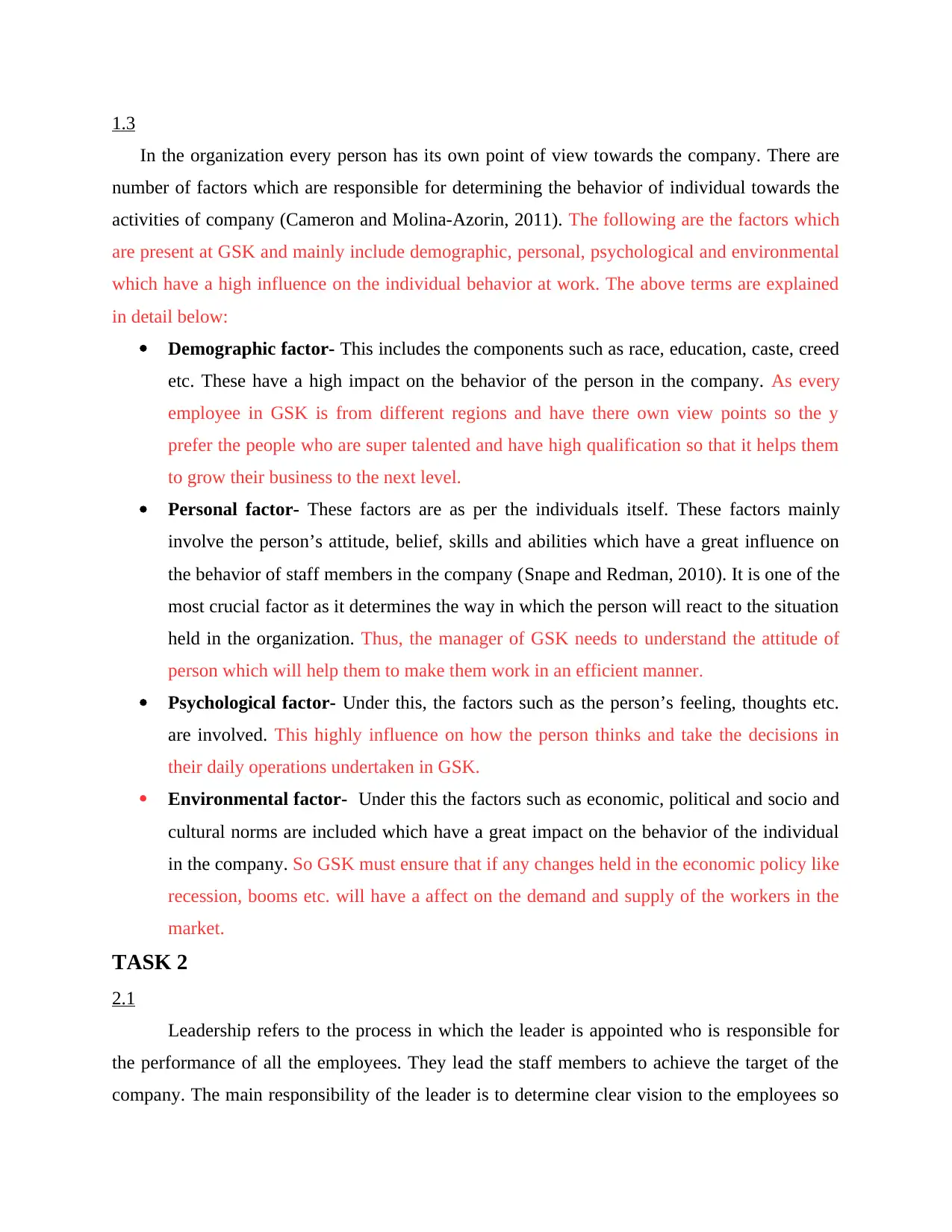
1.3
In the organization every person has its own point of view towards the company. There are
number of factors which are responsible for determining the behavior of individual towards the
activities of company (Cameron and Molina-Azorin, 2011). The following are the factors which
are present at GSK and mainly include demographic, personal, psychological and environmental
which have a high influence on the individual behavior at work. The above terms are explained
in detail below:
Demographic factor- This includes the components such as race, education, caste, creed
etc. These have a high impact on the behavior of the person in the company. As every
employee in GSK is from different regions and have there own view points so the y
prefer the people who are super talented and have high qualification so that it helps them
to grow their business to the next level.
Personal factor- These factors are as per the individuals itself. These factors mainly
involve the person’s attitude, belief, skills and abilities which have a great influence on
the behavior of staff members in the company (Snape and Redman, 2010). It is one of the
most crucial factor as it determines the way in which the person will react to the situation
held in the organization. Thus, the manager of GSK needs to understand the attitude of
person which will help them to make them work in an efficient manner.
Psychological factor- Under this, the factors such as the person’s feeling, thoughts etc.
are involved. This highly influence on how the person thinks and take the decisions in
their daily operations undertaken in GSK.
Environmental factor- Under this the factors such as economic, political and socio and
cultural norms are included which have a great impact on the behavior of the individual
in the company. So GSK must ensure that if any changes held in the economic policy like
recession, booms etc. will have a affect on the demand and supply of the workers in the
market.
TASK 2
2.1
Leadership refers to the process in which the leader is appointed who is responsible for
the performance of all the employees. They lead the staff members to achieve the target of the
company. The main responsibility of the leader is to determine clear vision to the employees so
In the organization every person has its own point of view towards the company. There are
number of factors which are responsible for determining the behavior of individual towards the
activities of company (Cameron and Molina-Azorin, 2011). The following are the factors which
are present at GSK and mainly include demographic, personal, psychological and environmental
which have a high influence on the individual behavior at work. The above terms are explained
in detail below:
Demographic factor- This includes the components such as race, education, caste, creed
etc. These have a high impact on the behavior of the person in the company. As every
employee in GSK is from different regions and have there own view points so the y
prefer the people who are super talented and have high qualification so that it helps them
to grow their business to the next level.
Personal factor- These factors are as per the individuals itself. These factors mainly
involve the person’s attitude, belief, skills and abilities which have a great influence on
the behavior of staff members in the company (Snape and Redman, 2010). It is one of the
most crucial factor as it determines the way in which the person will react to the situation
held in the organization. Thus, the manager of GSK needs to understand the attitude of
person which will help them to make them work in an efficient manner.
Psychological factor- Under this, the factors such as the person’s feeling, thoughts etc.
are involved. This highly influence on how the person thinks and take the decisions in
their daily operations undertaken in GSK.
Environmental factor- Under this the factors such as economic, political and socio and
cultural norms are included which have a great impact on the behavior of the individual
in the company. So GSK must ensure that if any changes held in the economic policy like
recession, booms etc. will have a affect on the demand and supply of the workers in the
market.
TASK 2
2.1
Leadership refers to the process in which the leader is appointed who is responsible for
the performance of all the employees. They lead the staff members to achieve the target of the
company. The main responsibility of the leader is to determine clear vision to the employees so
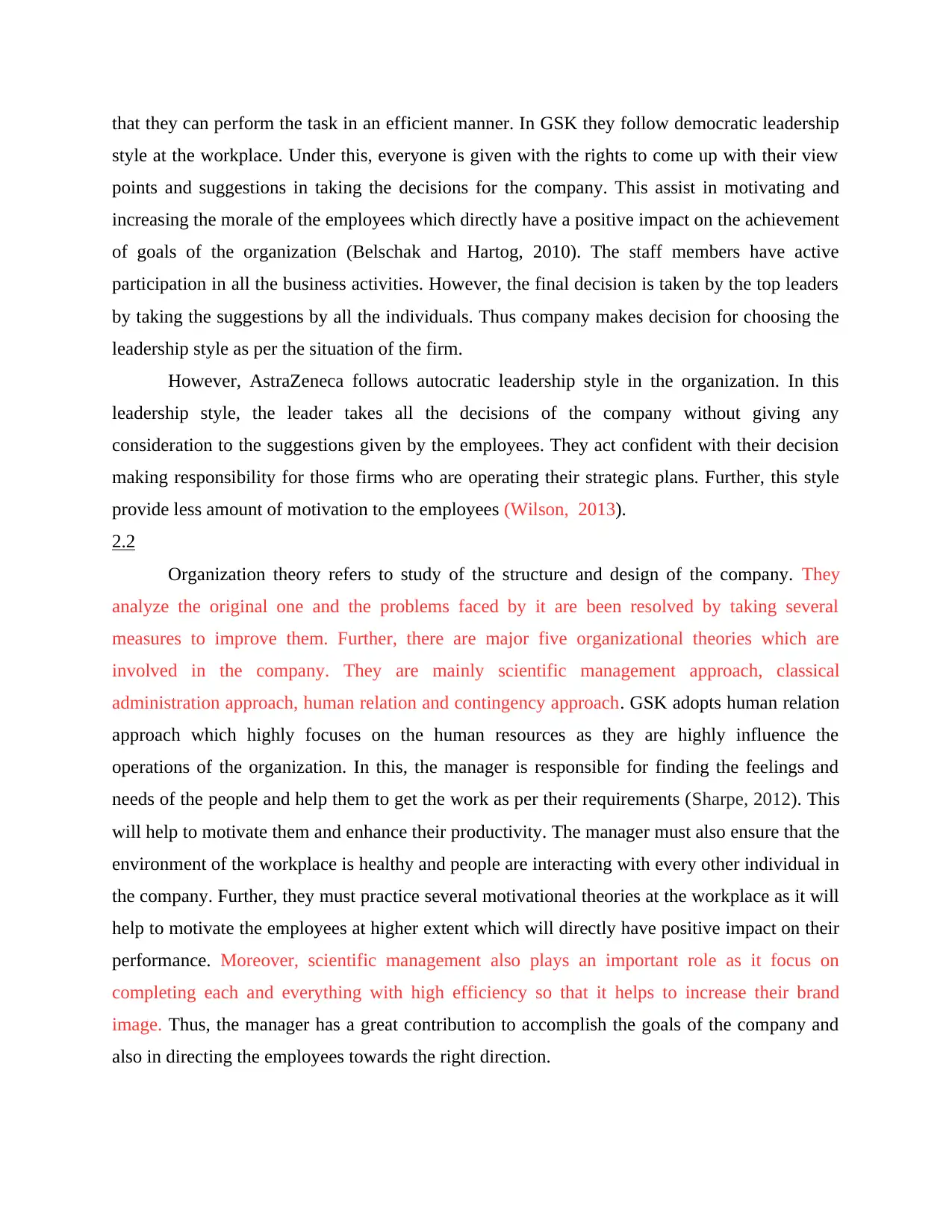
that they can perform the task in an efficient manner. In GSK they follow democratic leadership
style at the workplace. Under this, everyone is given with the rights to come up with their view
points and suggestions in taking the decisions for the company. This assist in motivating and
increasing the morale of the employees which directly have a positive impact on the achievement
of goals of the organization (Belschak and Hartog, 2010). The staff members have active
participation in all the business activities. However, the final decision is taken by the top leaders
by taking the suggestions by all the individuals. Thus company makes decision for choosing the
leadership style as per the situation of the firm.
However, AstraZeneca follows autocratic leadership style in the organization. In this
leadership style, the leader takes all the decisions of the company without giving any
consideration to the suggestions given by the employees. They act confident with their decision
making responsibility for those firms who are operating their strategic plans. Further, this style
provide less amount of motivation to the employees (Wilson, 2013).
2.2
Organization theory refers to study of the structure and design of the company. They
analyze the original one and the problems faced by it are been resolved by taking several
measures to improve them. Further, there are major five organizational theories which are
involved in the company. They are mainly scientific management approach, classical
administration approach, human relation and contingency approach. GSK adopts human relation
approach which highly focuses on the human resources as they are highly influence the
operations of the organization. In this, the manager is responsible for finding the feelings and
needs of the people and help them to get the work as per their requirements (Sharpe, 2012). This
will help to motivate them and enhance their productivity. The manager must also ensure that the
environment of the workplace is healthy and people are interacting with every other individual in
the company. Further, they must practice several motivational theories at the workplace as it will
help to motivate the employees at higher extent which will directly have positive impact on their
performance. Moreover, scientific management also plays an important role as it focus on
completing each and everything with high efficiency so that it helps to increase their brand
image. Thus, the manager has a great contribution to accomplish the goals of the company and
also in directing the employees towards the right direction.
style at the workplace. Under this, everyone is given with the rights to come up with their view
points and suggestions in taking the decisions for the company. This assist in motivating and
increasing the morale of the employees which directly have a positive impact on the achievement
of goals of the organization (Belschak and Hartog, 2010). The staff members have active
participation in all the business activities. However, the final decision is taken by the top leaders
by taking the suggestions by all the individuals. Thus company makes decision for choosing the
leadership style as per the situation of the firm.
However, AstraZeneca follows autocratic leadership style in the organization. In this
leadership style, the leader takes all the decisions of the company without giving any
consideration to the suggestions given by the employees. They act confident with their decision
making responsibility for those firms who are operating their strategic plans. Further, this style
provide less amount of motivation to the employees (Wilson, 2013).
2.2
Organization theory refers to study of the structure and design of the company. They
analyze the original one and the problems faced by it are been resolved by taking several
measures to improve them. Further, there are major five organizational theories which are
involved in the company. They are mainly scientific management approach, classical
administration approach, human relation and contingency approach. GSK adopts human relation
approach which highly focuses on the human resources as they are highly influence the
operations of the organization. In this, the manager is responsible for finding the feelings and
needs of the people and help them to get the work as per their requirements (Sharpe, 2012). This
will help to motivate them and enhance their productivity. The manager must also ensure that the
environment of the workplace is healthy and people are interacting with every other individual in
the company. Further, they must practice several motivational theories at the workplace as it will
help to motivate the employees at higher extent which will directly have positive impact on their
performance. Moreover, scientific management also plays an important role as it focus on
completing each and everything with high efficiency so that it helps to increase their brand
image. Thus, the manager has a great contribution to accomplish the goals of the company and
also in directing the employees towards the right direction.
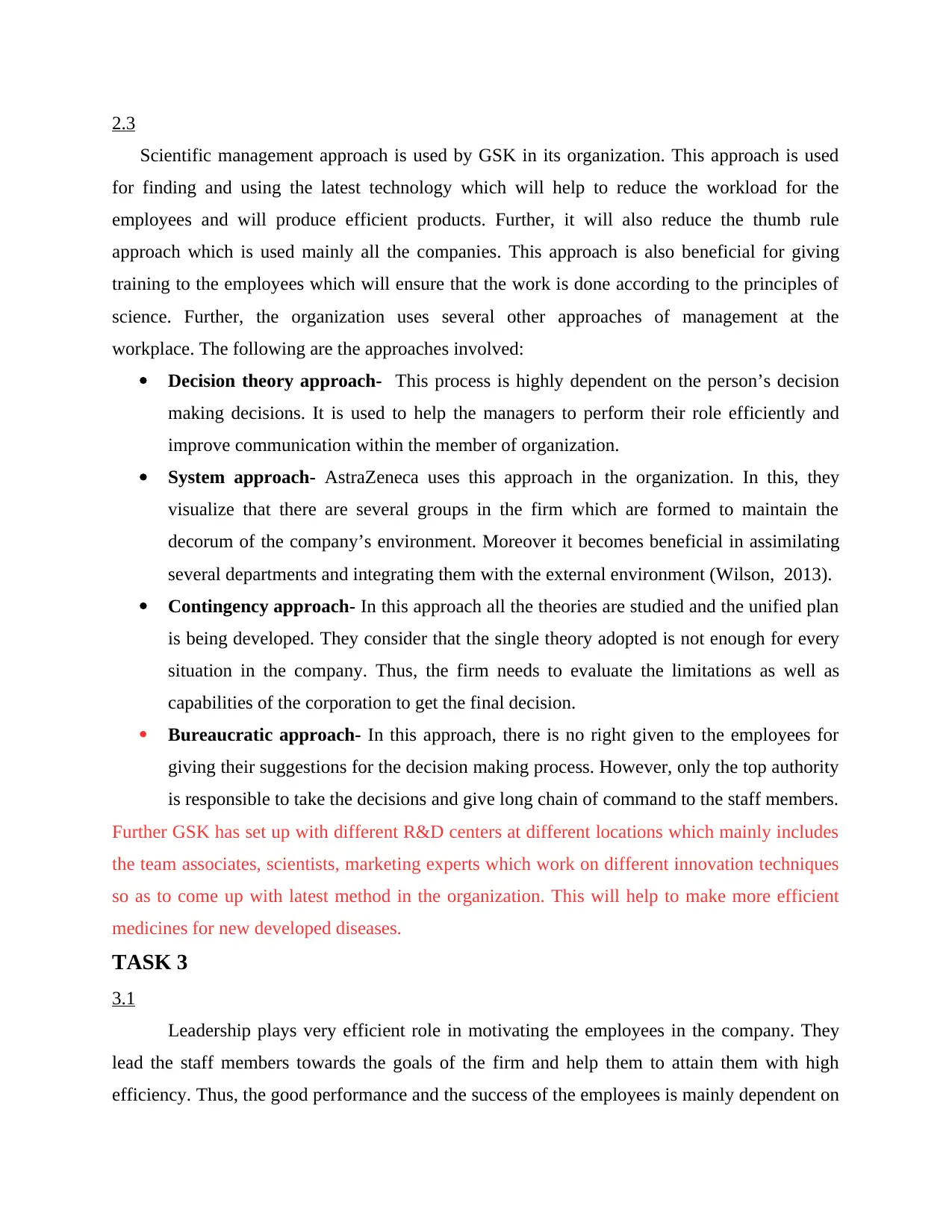
2.3
Scientific management approach is used by GSK in its organization. This approach is used
for finding and using the latest technology which will help to reduce the workload for the
employees and will produce efficient products. Further, it will also reduce the thumb rule
approach which is used mainly all the companies. This approach is also beneficial for giving
training to the employees which will ensure that the work is done according to the principles of
science. Further, the organization uses several other approaches of management at the
workplace. The following are the approaches involved:
Decision theory approach- This process is highly dependent on the person’s decision
making decisions. It is used to help the managers to perform their role efficiently and
improve communication within the member of organization.
System approach- AstraZeneca uses this approach in the organization. In this, they
visualize that there are several groups in the firm which are formed to maintain the
decorum of the company’s environment. Moreover it becomes beneficial in assimilating
several departments and integrating them with the external environment (Wilson, 2013).
Contingency approach- In this approach all the theories are studied and the unified plan
is being developed. They consider that the single theory adopted is not enough for every
situation in the company. Thus, the firm needs to evaluate the limitations as well as
capabilities of the corporation to get the final decision.
Bureaucratic approach- In this approach, there is no right given to the employees for
giving their suggestions for the decision making process. However, only the top authority
is responsible to take the decisions and give long chain of command to the staff members.
Further GSK has set up with different R&D centers at different locations which mainly includes
the team associates, scientists, marketing experts which work on different innovation techniques
so as to come up with latest method in the organization. This will help to make more efficient
medicines for new developed diseases.
TASK 3
3.1
Leadership plays very efficient role in motivating the employees in the company. They
lead the staff members towards the goals of the firm and help them to attain them with high
efficiency. Thus, the good performance and the success of the employees is mainly dependent on
Scientific management approach is used by GSK in its organization. This approach is used
for finding and using the latest technology which will help to reduce the workload for the
employees and will produce efficient products. Further, it will also reduce the thumb rule
approach which is used mainly all the companies. This approach is also beneficial for giving
training to the employees which will ensure that the work is done according to the principles of
science. Further, the organization uses several other approaches of management at the
workplace. The following are the approaches involved:
Decision theory approach- This process is highly dependent on the person’s decision
making decisions. It is used to help the managers to perform their role efficiently and
improve communication within the member of organization.
System approach- AstraZeneca uses this approach in the organization. In this, they
visualize that there are several groups in the firm which are formed to maintain the
decorum of the company’s environment. Moreover it becomes beneficial in assimilating
several departments and integrating them with the external environment (Wilson, 2013).
Contingency approach- In this approach all the theories are studied and the unified plan
is being developed. They consider that the single theory adopted is not enough for every
situation in the company. Thus, the firm needs to evaluate the limitations as well as
capabilities of the corporation to get the final decision.
Bureaucratic approach- In this approach, there is no right given to the employees for
giving their suggestions for the decision making process. However, only the top authority
is responsible to take the decisions and give long chain of command to the staff members.
Further GSK has set up with different R&D centers at different locations which mainly includes
the team associates, scientists, marketing experts which work on different innovation techniques
so as to come up with latest method in the organization. This will help to make more efficient
medicines for new developed diseases.
TASK 3
3.1
Leadership plays very efficient role in motivating the employees in the company. They
lead the staff members towards the goals of the firm and help them to attain them with high
efficiency. Thus, the good performance and the success of the employees is mainly dependent on
Paraphrase This Document
Need a fresh take? Get an instant paraphrase of this document with our AI Paraphraser
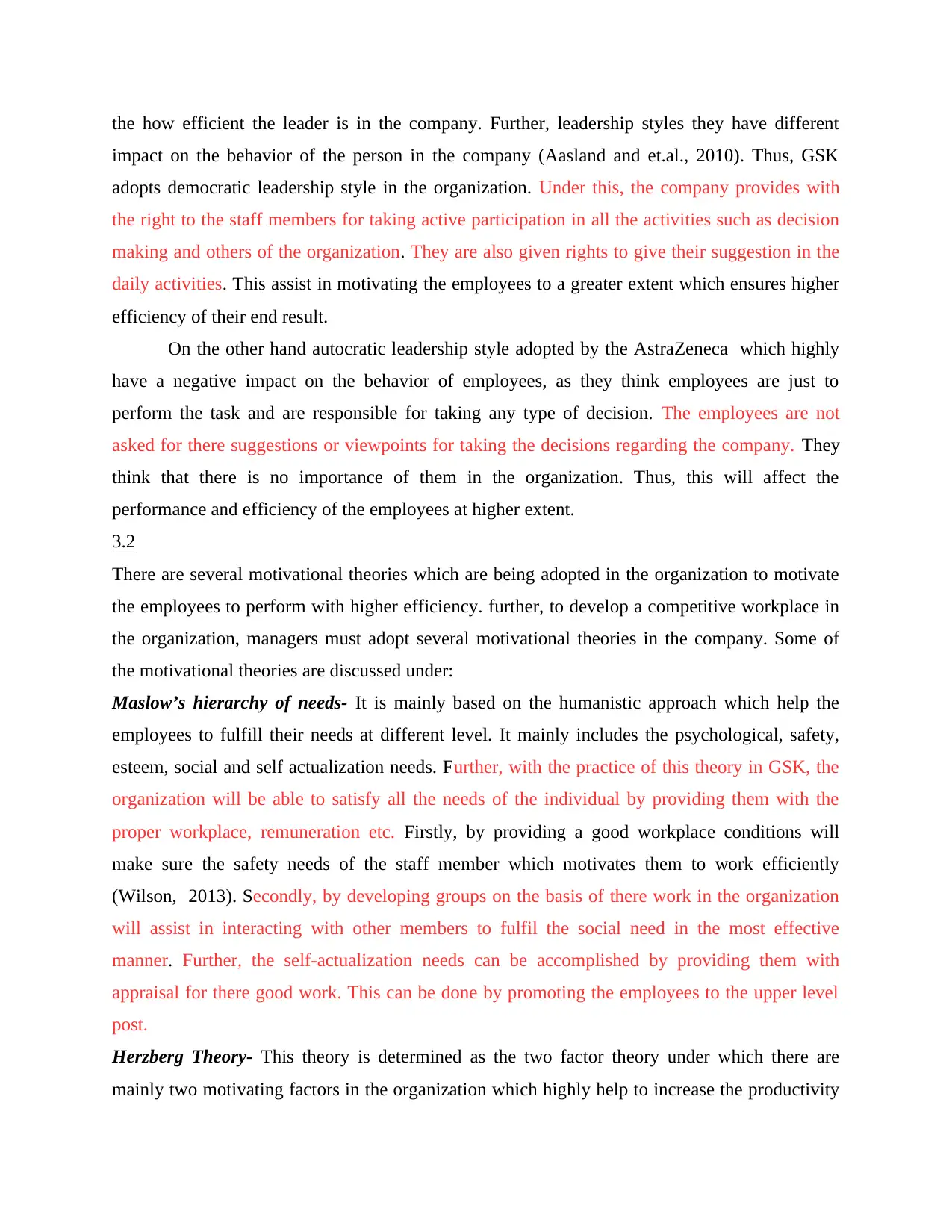
the how efficient the leader is in the company. Further, leadership styles they have different
impact on the behavior of the person in the company (Aasland and et.al., 2010). Thus, GSK
adopts democratic leadership style in the organization. Under this, the company provides with
the right to the staff members for taking active participation in all the activities such as decision
making and others of the organization. They are also given rights to give their suggestion in the
daily activities. This assist in motivating the employees to a greater extent which ensures higher
efficiency of their end result.
On the other hand autocratic leadership style adopted by the AstraZeneca which highly
have a negative impact on the behavior of employees, as they think employees are just to
perform the task and are responsible for taking any type of decision. The employees are not
asked for there suggestions or viewpoints for taking the decisions regarding the company. They
think that there is no importance of them in the organization. Thus, this will affect the
performance and efficiency of the employees at higher extent.
3.2
There are several motivational theories which are being adopted in the organization to motivate
the employees to perform with higher efficiency. further, to develop a competitive workplace in
the organization, managers must adopt several motivational theories in the company. Some of
the motivational theories are discussed under:
Maslow’s hierarchy of needs- It is mainly based on the humanistic approach which help the
employees to fulfill their needs at different level. It mainly includes the psychological, safety,
esteem, social and self actualization needs. Further, with the practice of this theory in GSK, the
organization will be able to satisfy all the needs of the individual by providing them with the
proper workplace, remuneration etc. Firstly, by providing a good workplace conditions will
make sure the safety needs of the staff member which motivates them to work efficiently
(Wilson, 2013). Secondly, by developing groups on the basis of there work in the organization
will assist in interacting with other members to fulfil the social need in the most effective
manner. Further, the self-actualization needs can be accomplished by providing them with
appraisal for there good work. This can be done by promoting the employees to the upper level
post.
Herzberg Theory- This theory is determined as the two factor theory under which there are
mainly two motivating factors in the organization which highly help to increase the productivity
impact on the behavior of the person in the company (Aasland and et.al., 2010). Thus, GSK
adopts democratic leadership style in the organization. Under this, the company provides with
the right to the staff members for taking active participation in all the activities such as decision
making and others of the organization. They are also given rights to give their suggestion in the
daily activities. This assist in motivating the employees to a greater extent which ensures higher
efficiency of their end result.
On the other hand autocratic leadership style adopted by the AstraZeneca which highly
have a negative impact on the behavior of employees, as they think employees are just to
perform the task and are responsible for taking any type of decision. The employees are not
asked for there suggestions or viewpoints for taking the decisions regarding the company. They
think that there is no importance of them in the organization. Thus, this will affect the
performance and efficiency of the employees at higher extent.
3.2
There are several motivational theories which are being adopted in the organization to motivate
the employees to perform with higher efficiency. further, to develop a competitive workplace in
the organization, managers must adopt several motivational theories in the company. Some of
the motivational theories are discussed under:
Maslow’s hierarchy of needs- It is mainly based on the humanistic approach which help the
employees to fulfill their needs at different level. It mainly includes the psychological, safety,
esteem, social and self actualization needs. Further, with the practice of this theory in GSK, the
organization will be able to satisfy all the needs of the individual by providing them with the
proper workplace, remuneration etc. Firstly, by providing a good workplace conditions will
make sure the safety needs of the staff member which motivates them to work efficiently
(Wilson, 2013). Secondly, by developing groups on the basis of there work in the organization
will assist in interacting with other members to fulfil the social need in the most effective
manner. Further, the self-actualization needs can be accomplished by providing them with
appraisal for there good work. This can be done by promoting the employees to the upper level
post.
Herzberg Theory- This theory is determined as the two factor theory under which there are
mainly two motivating factors in the organization which highly help to increase the productivity
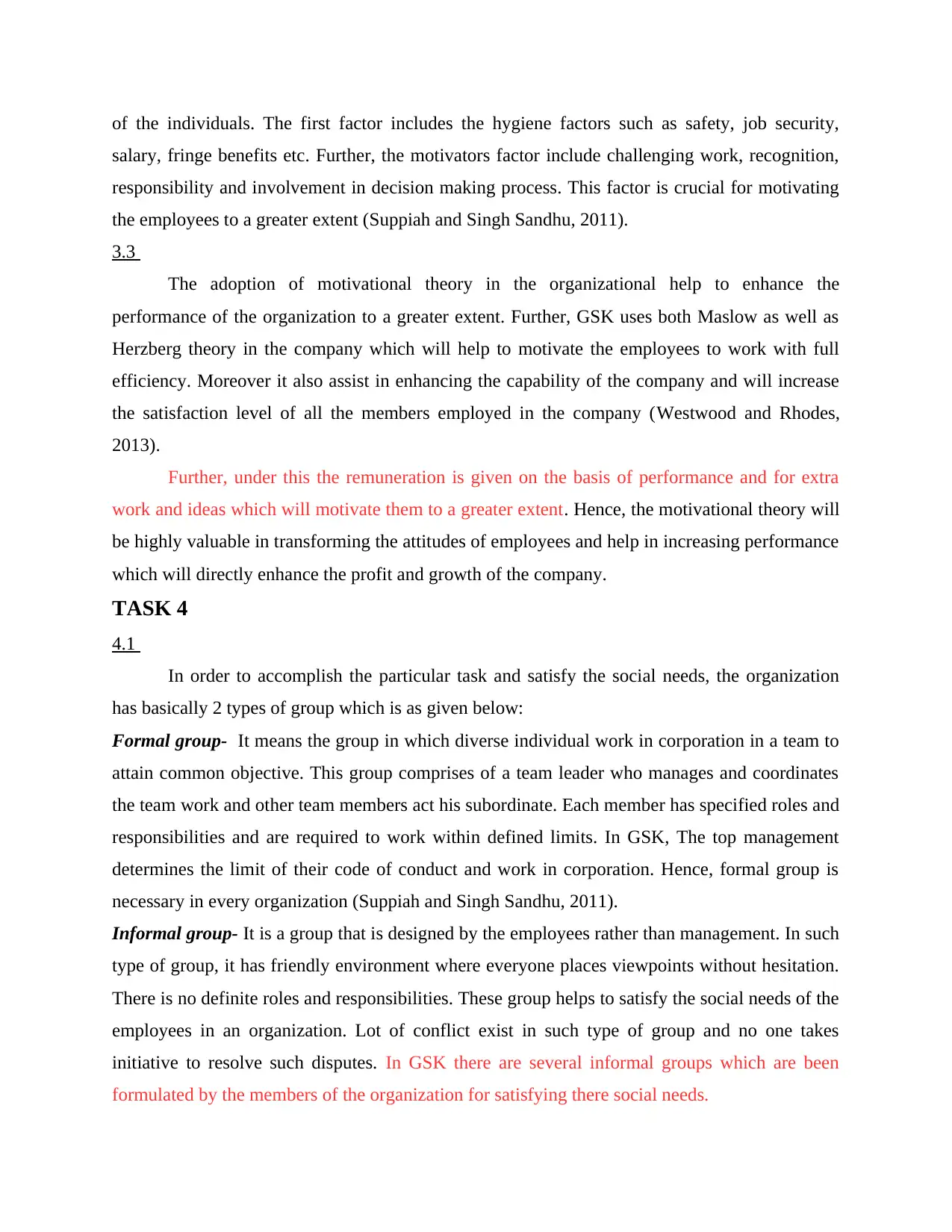
of the individuals. The first factor includes the hygiene factors such as safety, job security,
salary, fringe benefits etc. Further, the motivators factor include challenging work, recognition,
responsibility and involvement in decision making process. This factor is crucial for motivating
the employees to a greater extent (Suppiah and Singh Sandhu, 2011).
3.3
The adoption of motivational theory in the organizational help to enhance the
performance of the organization to a greater extent. Further, GSK uses both Maslow as well as
Herzberg theory in the company which will help to motivate the employees to work with full
efficiency. Moreover it also assist in enhancing the capability of the company and will increase
the satisfaction level of all the members employed in the company (Westwood and Rhodes,
2013).
Further, under this the remuneration is given on the basis of performance and for extra
work and ideas which will motivate them to a greater extent. Hence, the motivational theory will
be highly valuable in transforming the attitudes of employees and help in increasing performance
which will directly enhance the profit and growth of the company.
TASK 4
4.1
In order to accomplish the particular task and satisfy the social needs, the organization
has basically 2 types of group which is as given below:
Formal group- It means the group in which diverse individual work in corporation in a team to
attain common objective. This group comprises of a team leader who manages and coordinates
the team work and other team members act his subordinate. Each member has specified roles and
responsibilities and are required to work within defined limits. In GSK, The top management
determines the limit of their code of conduct and work in corporation. Hence, formal group is
necessary in every organization (Suppiah and Singh Sandhu, 2011).
Informal group- It is a group that is designed by the employees rather than management. In such
type of group, it has friendly environment where everyone places viewpoints without hesitation.
There is no definite roles and responsibilities. These group helps to satisfy the social needs of the
employees in an organization. Lot of conflict exist in such type of group and no one takes
initiative to resolve such disputes. In GSK there are several informal groups which are been
formulated by the members of the organization for satisfying there social needs.
salary, fringe benefits etc. Further, the motivators factor include challenging work, recognition,
responsibility and involvement in decision making process. This factor is crucial for motivating
the employees to a greater extent (Suppiah and Singh Sandhu, 2011).
3.3
The adoption of motivational theory in the organizational help to enhance the
performance of the organization to a greater extent. Further, GSK uses both Maslow as well as
Herzberg theory in the company which will help to motivate the employees to work with full
efficiency. Moreover it also assist in enhancing the capability of the company and will increase
the satisfaction level of all the members employed in the company (Westwood and Rhodes,
2013).
Further, under this the remuneration is given on the basis of performance and for extra
work and ideas which will motivate them to a greater extent. Hence, the motivational theory will
be highly valuable in transforming the attitudes of employees and help in increasing performance
which will directly enhance the profit and growth of the company.
TASK 4
4.1
In order to accomplish the particular task and satisfy the social needs, the organization
has basically 2 types of group which is as given below:
Formal group- It means the group in which diverse individual work in corporation in a team to
attain common objective. This group comprises of a team leader who manages and coordinates
the team work and other team members act his subordinate. Each member has specified roles and
responsibilities and are required to work within defined limits. In GSK, The top management
determines the limit of their code of conduct and work in corporation. Hence, formal group is
necessary in every organization (Suppiah and Singh Sandhu, 2011).
Informal group- It is a group that is designed by the employees rather than management. In such
type of group, it has friendly environment where everyone places viewpoints without hesitation.
There is no definite roles and responsibilities. These group helps to satisfy the social needs of the
employees in an organization. Lot of conflict exist in such type of group and no one takes
initiative to resolve such disputes. In GSK there are several informal groups which are been
formulated by the members of the organization for satisfying there social needs.
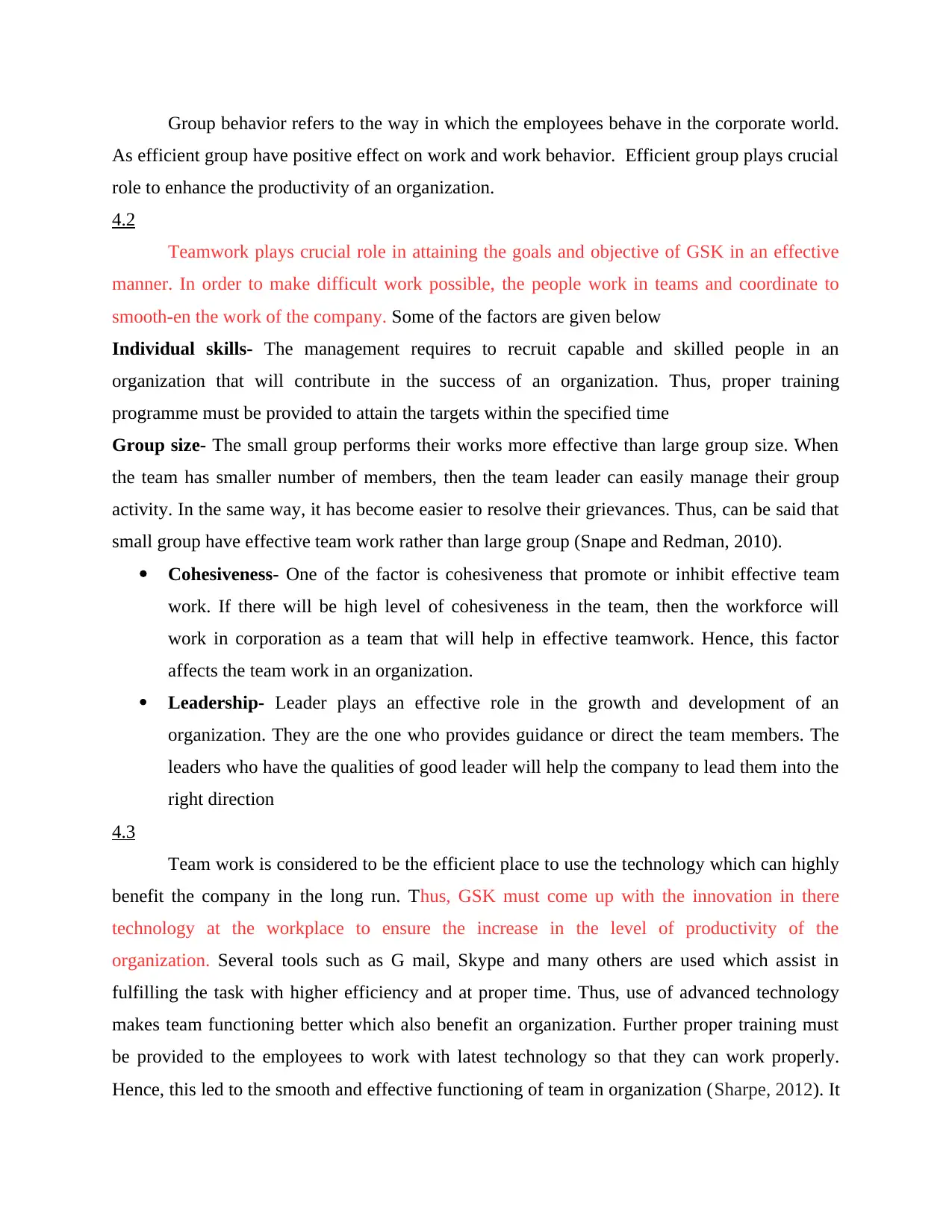
Group behavior refers to the way in which the employees behave in the corporate world.
As efficient group have positive effect on work and work behavior. Efficient group plays crucial
role to enhance the productivity of an organization.
4.2
Teamwork plays crucial role in attaining the goals and objective of GSK in an effective
manner. In order to make difficult work possible, the people work in teams and coordinate to
smooth-en the work of the company. Some of the factors are given below
Individual skills- The management requires to recruit capable and skilled people in an
organization that will contribute in the success of an organization. Thus, proper training
programme must be provided to attain the targets within the specified time
Group size- The small group performs their works more effective than large group size. When
the team has smaller number of members, then the team leader can easily manage their group
activity. In the same way, it has become easier to resolve their grievances. Thus, can be said that
small group have effective team work rather than large group (Snape and Redman, 2010).
Cohesiveness- One of the factor is cohesiveness that promote or inhibit effective team
work. If there will be high level of cohesiveness in the team, then the workforce will
work in corporation as a team that will help in effective teamwork. Hence, this factor
affects the team work in an organization.
Leadership- Leader plays an effective role in the growth and development of an
organization. They are the one who provides guidance or direct the team members. The
leaders who have the qualities of good leader will help the company to lead them into the
right direction
4.3
Team work is considered to be the efficient place to use the technology which can highly
benefit the company in the long run. Thus, GSK must come up with the innovation in there
technology at the workplace to ensure the increase in the level of productivity of the
organization. Several tools such as G mail, Skype and many others are used which assist in
fulfilling the task with higher efficiency and at proper time. Thus, use of advanced technology
makes team functioning better which also benefit an organization. Further proper training must
be provided to the employees to work with latest technology so that they can work properly.
Hence, this led to the smooth and effective functioning of team in organization (Sharpe, 2012). It
As efficient group have positive effect on work and work behavior. Efficient group plays crucial
role to enhance the productivity of an organization.
4.2
Teamwork plays crucial role in attaining the goals and objective of GSK in an effective
manner. In order to make difficult work possible, the people work in teams and coordinate to
smooth-en the work of the company. Some of the factors are given below
Individual skills- The management requires to recruit capable and skilled people in an
organization that will contribute in the success of an organization. Thus, proper training
programme must be provided to attain the targets within the specified time
Group size- The small group performs their works more effective than large group size. When
the team has smaller number of members, then the team leader can easily manage their group
activity. In the same way, it has become easier to resolve their grievances. Thus, can be said that
small group have effective team work rather than large group (Snape and Redman, 2010).
Cohesiveness- One of the factor is cohesiveness that promote or inhibit effective team
work. If there will be high level of cohesiveness in the team, then the workforce will
work in corporation as a team that will help in effective teamwork. Hence, this factor
affects the team work in an organization.
Leadership- Leader plays an effective role in the growth and development of an
organization. They are the one who provides guidance or direct the team members. The
leaders who have the qualities of good leader will help the company to lead them into the
right direction
4.3
Team work is considered to be the efficient place to use the technology which can highly
benefit the company in the long run. Thus, GSK must come up with the innovation in there
technology at the workplace to ensure the increase in the level of productivity of the
organization. Several tools such as G mail, Skype and many others are used which assist in
fulfilling the task with higher efficiency and at proper time. Thus, use of advanced technology
makes team functioning better which also benefit an organization. Further proper training must
be provided to the employees to work with latest technology so that they can work properly.
Hence, this led to the smooth and effective functioning of team in organization (Sharpe, 2012). It
Secure Best Marks with AI Grader
Need help grading? Try our AI Grader for instant feedback on your assignments.
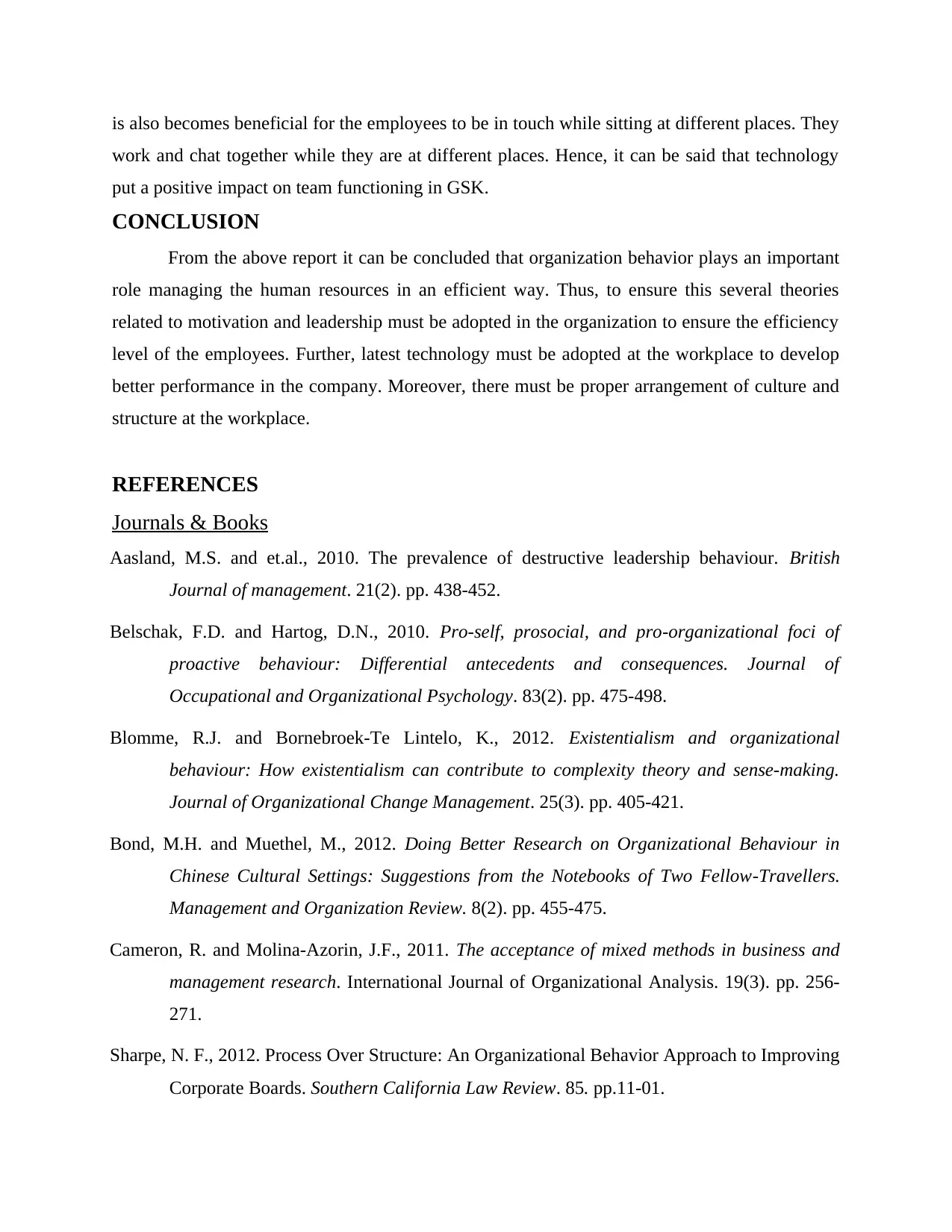
is also becomes beneficial for the employees to be in touch while sitting at different places. They
work and chat together while they are at different places. Hence, it can be said that technology
put a positive impact on team functioning in GSK.
CONCLUSION
From the above report it can be concluded that organization behavior plays an important
role managing the human resources in an efficient way. Thus, to ensure this several theories
related to motivation and leadership must be adopted in the organization to ensure the efficiency
level of the employees. Further, latest technology must be adopted at the workplace to develop
better performance in the company. Moreover, there must be proper arrangement of culture and
structure at the workplace.
REFERENCES
Journals & Books
Aasland, M.S. and et.al., 2010. The prevalence of destructive leadership behaviour. British
Journal of management. 21(2). pp. 438-452.
Belschak, F.D. and Hartog, D.N., 2010. Pro‐self, prosocial, and pro‐organizational foci of
proactive behaviour: Differential antecedents and consequences. Journal of
Occupational and Organizational Psychology. 83(2). pp. 475-498.
Blomme, R.J. and Bornebroek-Te Lintelo, K., 2012. Existentialism and organizational
behaviour: How existentialism can contribute to complexity theory and sense-making.
Journal of Organizational Change Management. 25(3). pp. 405-421.
Bond, M.H. and Muethel, M., 2012. Doing Better Research on Organizational Behaviour in
Chinese Cultural Settings: Suggestions from the Notebooks of Two Fellow‐Travellers.
Management and Organization Review. 8(2). pp. 455-475.
Cameron, R. and Molina-Azorin, J.F., 2011. The acceptance of mixed methods in business and
management research. International Journal of Organizational Analysis. 19(3). pp. 256-
271.
Sharpe, N. F., 2012. Process Over Structure: An Organizational Behavior Approach to Improving
Corporate Boards. Southern California Law Review. 85. pp.11-01.
work and chat together while they are at different places. Hence, it can be said that technology
put a positive impact on team functioning in GSK.
CONCLUSION
From the above report it can be concluded that organization behavior plays an important
role managing the human resources in an efficient way. Thus, to ensure this several theories
related to motivation and leadership must be adopted in the organization to ensure the efficiency
level of the employees. Further, latest technology must be adopted at the workplace to develop
better performance in the company. Moreover, there must be proper arrangement of culture and
structure at the workplace.
REFERENCES
Journals & Books
Aasland, M.S. and et.al., 2010. The prevalence of destructive leadership behaviour. British
Journal of management. 21(2). pp. 438-452.
Belschak, F.D. and Hartog, D.N., 2010. Pro‐self, prosocial, and pro‐organizational foci of
proactive behaviour: Differential antecedents and consequences. Journal of
Occupational and Organizational Psychology. 83(2). pp. 475-498.
Blomme, R.J. and Bornebroek-Te Lintelo, K., 2012. Existentialism and organizational
behaviour: How existentialism can contribute to complexity theory and sense-making.
Journal of Organizational Change Management. 25(3). pp. 405-421.
Bond, M.H. and Muethel, M., 2012. Doing Better Research on Organizational Behaviour in
Chinese Cultural Settings: Suggestions from the Notebooks of Two Fellow‐Travellers.
Management and Organization Review. 8(2). pp. 455-475.
Cameron, R. and Molina-Azorin, J.F., 2011. The acceptance of mixed methods in business and
management research. International Journal of Organizational Analysis. 19(3). pp. 256-
271.
Sharpe, N. F., 2012. Process Over Structure: An Organizational Behavior Approach to Improving
Corporate Boards. Southern California Law Review. 85. pp.11-01.
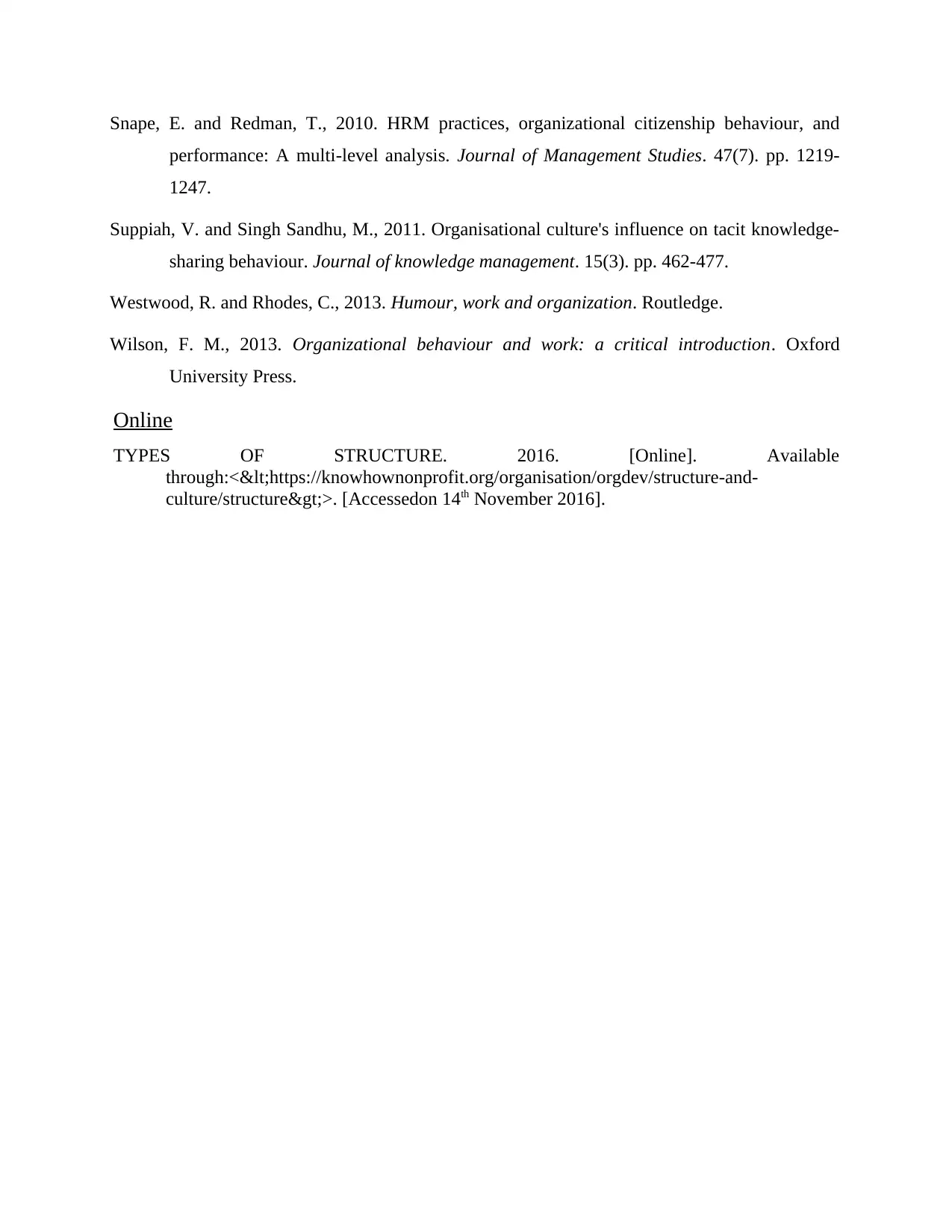
Snape, E. and Redman, T., 2010. HRM practices, organizational citizenship behaviour, and
performance: A multi‐level analysis. Journal of Management Studies. 47(7). pp. 1219-
1247.
Suppiah, V. and Singh Sandhu, M., 2011. Organisational culture's influence on tacit knowledge-
sharing behaviour. Journal of knowledge management. 15(3). pp. 462-477.
Westwood, R. and Rhodes, C., 2013. Humour, work and organization. Routledge.
Wilson, F. M., 2013. Organizational behaviour and work: a critical introduction. Oxford
University Press.
Online
TYPES OF STRUCTURE. 2016. [Online]. Available
through:<<https://knowhownonprofit.org/organisation/orgdev/structure-and-
culture/structure>>. [Accessedon 14th November 2016].
performance: A multi‐level analysis. Journal of Management Studies. 47(7). pp. 1219-
1247.
Suppiah, V. and Singh Sandhu, M., 2011. Organisational culture's influence on tacit knowledge-
sharing behaviour. Journal of knowledge management. 15(3). pp. 462-477.
Westwood, R. and Rhodes, C., 2013. Humour, work and organization. Routledge.
Wilson, F. M., 2013. Organizational behaviour and work: a critical introduction. Oxford
University Press.
Online
TYPES OF STRUCTURE. 2016. [Online]. Available
through:<<https://knowhownonprofit.org/organisation/orgdev/structure-and-
culture/structure>>. [Accessedon 14th November 2016].
1 out of 12
Related Documents
Your All-in-One AI-Powered Toolkit for Academic Success.
+13062052269
info@desklib.com
Available 24*7 on WhatsApp / Email
![[object Object]](/_next/static/media/star-bottom.7253800d.svg)
Unlock your academic potential
© 2024 | Zucol Services PVT LTD | All rights reserved.





